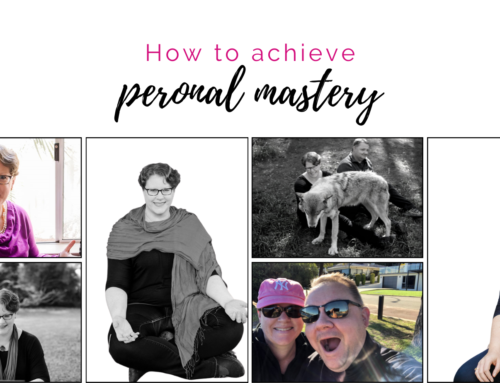We’ve been taught for decades that being stressed is normal.
There’s a perception that if you’re not stressed, then you’re not working hard enough, and the pressure is piled on for you to ‘lift your game’.
If others around you are struggling under the weight of the things they need to deliver, but you’re sailing along and having a jolly good time, then you’re not a team player.
The ostraciscm, judgement and criticism are enough to make you run and create some stress, just so you fit in.
We’ve adapted to being exhausted, to pushing ourselves and to forcing ourselves to keep going.
But now, there’s a movement gaining momentum that’s telling us that stress is our enemy, and that we have to do everything we can to eliminate it from our lives.
But who’s going to be brave enough to be the first person to do things differently?
Who’s going to take the brunt of the ‘pack mentality’ and forge the way forwards without stress in their lives?
It’s hard to know which way to turn.
Do we follow what we’ve been taught is ‘the way’, and continue to live life in the way we know? Or do we start to acknowledge the new movement and find a different way forwards?
There’s certainly plenty of research that’s been conducted worldwide to investigate what the true impact of stress is on our lives … and the results show that we need to make some changes, or pay the ultimate price.
It’s becoming clearer that maintaining the status quo is costing organisations big time – around US$1 Trillion a year.
Global business is starting to see the light, and is starting to come around to the thought that a healthy workforce means a healthier bottom line … but then gets caught wondering where to start in helping their human resources to regain their health.
Everyone is left wondering what the next ‘right’ move is.
The World Health Organisation (WHO) re-defined burnout at the end of May 2019, directly linking it to workplace stress.
Without it being said, this created the impression that the workplace should therefore be responsible for solving the stress of its individuals.
Surveys conducted since then indicate that around 80% of workers agree, and that they expect their workplace to start the conversation around mental health and provide training and education.
But there are a number of significant risks to consider when relying on your employer to provide you with solutions to YOUR stress.
1. Your stress is unique to you.
We are all extraordinary, unique individuals. We have different life experiences, and we see and react to the world in different ways depending on the effect these experiences have had. What stresses me out, for example, won’t be the same as what stresses you out.
Most organisations want to help their employees, but remember that they have to find a way to provide stress reduction solutions that can be applied to EVERYONE, and almost always via a group format.
What if what your organisation thinks is the stress problem isn’t what you are experiencing? How much value will you get out of the training that is offered?
2. You need to deal with stress on your timeframe.
If you wait for your organisation to provide you with resources to solve your stress, you could be sitting in your stress for way too long. Your company might not provide the solution you need for years – they might provide something that’s too group oriented (and you can’t easily apply it to your situation) or you might simply find that what is being offered isn’t relevant to you at all.
If you’re stressed, then now’s the time to find your ideal solution – when it’s right for you.
3. What you need should be determined by you.
It’s YOUR stress, so the best solutions will be found by you. You’re the only one who knows (or can determine) where your stress is coming from, so you’re the only one who really knows what it is you need.
You can’t outsource finding your solutions to someone else; you need to step up and work it out for yourself, to make sure you get exactly the right fix for you.
Starting doesn’t have to be hard … or overwhelming.
Sometimes we think that if we leave the responsibility of our health and wellbeing in the hands of others that we don’t have to worry about when, or how, to start.
But what’s the point of knowing the when and how if what you’re stepping into isn’t right for you?
Our conditioning has taught us that making changes in our lives is hard, and therefore not worth it.
Generally, beliving this makes doing even the smallest thing differently seem difficult, and it makes facing those times in life when change is forced on us seem almost insurmountable.
Starting can be as simple as taking a look at what it is that is causing stress in YOUR life.
Look at all the different areas of your life and start writing down what it is that causes you stress. Look beyond just work, because even though we’ve been traditionally taught that stress is caused by work, it comes from so many other places in our lives.
Your answers are all you need.
Knowledge is power, because once you’ve made your list, you’ve got a place to start. Without knowing it you’ve already taken a step forwards.
Take your list and choose one thing, and make that your focus. Then, write down three simple things you can do to help you to reduce your stress around that thing. Next, for each of those simple things create three simple steps you can take. Start with the first step for the first thing and focus on taking that step as often as you can.
This gives you a simple step that kills overwhelm in its tracks.
Nothing happens without taking action. It’s the step – just one at a time – that creates momentum. It’s your ability to stay focused and keep taking a one step at a time that will move your life forwards in a different way.
What will your first step be?
If you want to access more resources to help you to move forward in a different way, you can find loads in the articles and videos in my FREE email series – it’s a great way to help you begin your journey. Simply click here to start you on your way.
Bronwen Sciortino is a Simplicity Expert, an internationally renowned author and professional speaker and. You can follow her at her website; Facebook, Instagram, or LinkedIn.







